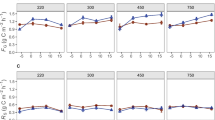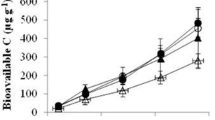Abstract
Previous studies have found that root carbon inputs to the soil can stimulate the mineralization of existing soil carbon (C) pools. It is still uncertain, however, whether this “primed” C is derived from elevated rates of soil organic matter (SOM) decomposition, greater C release from microbial pools, or both. The goal of this research was to determine how the activities of the microbial exoenzymes that control SOM decomposition are affected by root C inputs. This was done by manipulating rhizodeposition with tree girdling in a coniferous subalpine forest in the Rocky Mountains of Colorado, USA, and following changes in the activities of nine exoenzymes involved in decomposition, as well as soil dissolved organic C, dissolved organic and inorganic nitrogen (N), and microbial biomass C and N. We found that rhizodeposition is high in the spring, when the soils are still snow-covered, and that there are large ephemeral populations of microorganisms dependent upon this C. Microbial N acquisition from peptide degradation increased with increases in microbial biomass when rhizodeposition was highest. However, our data indicate that the breakdown of cellulose, lignin, chitin, and organic phosphorus are not affected by springtime increases in soil microbial biomass associated with increases in rhizodeposition. We conclude that the priming of soil C mineralization by rhizodeposition is due to growth of the microbial biomass and an increase in the breakdown of N-rich proteins, but not due to increases in the degradation of plant litter constituents such as cellulose and lignin.






Similar content being viewed by others
References
Bardgett RD (2005) The biology of soil: a community and ecosystem approach. Oxford University Press, New York, pp 120–121
Bertin C, Yang X, Weston LA (2003) The role of root exudates and allelochemicals in the rhizosphere. Plant Soil 256:67–83
Bhupinderpal-Singh, Nordgren A, Lofvenius MO, Högberg MN, Mellander PE, Högberg P (2003) Tree root and soil heterotrophic respiration as revealed by girdling of boreal Scots pine forest: extending observations beyond the first year. Plant Cell Environ 26:1287–1296
Bonkowski M (2004) Protozoa and plant growth: the microbial loop in soil revisited. New Phytol 162:617–631
Brookes PC, Landman A, Pruden G, Jenkinson DS (1985) Chloroform fumigation and the release of soil nitrogen: a rapid direct extraction method to measure microbial biomass nitrogen in soil. Soil Biol Biochem 17:837–842
Cheng W, Zhang Q, Coleman DC, Carroll CR, Hoffman CA (1996) Is available carbon limiting microbial respiration in the rhizosphere? Soil Biol Biochem 28:1283–1288
Clarholm M (1985) Interactions of bacteria, protozoa and plants leading to mineralization of soil nitrogen. Soil Biol Biochem 17:181–188
Dalenberg JW, Jager G (1981) Priming effect of small glucose additions to C-14-labeled soil. Soil Biol Biochem 13:219–223
Dalenberg JW, Jager G (1989) Priming effect of some organic additions to C-14-labeled soil. Soil Biol Biochem 21:443–448
De Nobili M, Contin M, Mondini C, Brookes PC (2001) Soil microbial biomass is triggered into activity by trace amounts of substrate. Soil Biol Biochem 33:1163
Fontaine S, Bardoux G, Benest D, Verdier B, Mariotti A, Abbadie L (2004) Mechanisms of the priming effect in a savannah soil amended with cellulose. Soil Sci Soc Am J 68:125–131
Hamilton EW, Frank DA (2001) Can plants stimulate soil microbes and their own nutrient supply? Evidence from a grazing tolerant grass. Ecology 82:2397–2402
Högberg P, Ekblad A (1996) Substrate-induced respiration measured in situ in a C3-plant ecosystem using additions of C4-sucrose. Soil Biol Biochem 28:1131
Högberg MN, Högberg P (2002) Extramatrical ectomycorrhizal mycelium contributes one-third of microbial biomass and produces, together with associated roots, half the dissolved organic carbon in a forest soil. New Phytol 154:791–795
Högberg P, Nordgren A, Buchmann N, Taylor AFS, Ekblad A, Högberg MN, Nyberg G, Ottosson-Lofvenius M, Read DJ (2001) Large-scale forest girdling shows that current photosynthesis drives soil respiration. Nature 411:789–792
Hutsch BW, Augustin J, Merbach W (2002) Plant rhizodeposition: an important source for carbon turnover in soils. J Plant Nutr Soil Sci 165:397–407
Kuzyakov Y (2002) Review: factors affecting rhizosphere priming effects. J Plant Nutr Soil Sc 165:382–396
Kuzyakov Y, Friedel JK, Stahr K (2000) Review of mechanisms and quantification of priming effects. Soil Biol Biochem 32:1485–1498
Mary B, Fresneau C, Morel JL, Mariotti A (1993) C and N cycling during decomposition of root mucilage, roots and glucose in soil. Soil Biol Biochem 25:1005
Monson RK, Lipson DL, Burns SP, Turnipseed AA, Delany AC, Williams MW, Schmidt SK (2006) Winter forest soil respiration controlled by climate and microbial community composition. Nature 439:711
Monson RK, Turnipseed AA, Sparks JP, Harley PC, Scott-Denton LE, Sparks K, Huxman TE (2002) Carbon sequestration in a high-elevation, subalpine forest. Global Change Biol 8:459–478
Paterson E (2003) Importance of rhizodeposition in the coupling of plant and microbial productivity. Eur J Soil Sci 54:741–750
Patterson DE, Smith MW (1981) The measurement of unfrozen water-content by time domain reflectometry: results from laboratory tests. Can Geotech J 18:131–144
Saiya-Cork KR, Sinsabaugh RL, Zak DR (2002) The effects of long-term nitrogen deposition on extracellular enzyme activity in an Acer saccharum forest soil. Soil Biol Biochem 34:1309–1315
Scott-Denton LE, Rosenstiel TN, Monson RK (2006) Differential controls by climate and substrate over the heterotrophic and rhizospheric components of soil respiration. Global Change Biol 12:205–216
Scott-Denton LE, Sparks KL, Monson RK (2003) Spatial and temporal controls of soil respiration rate in a high-elevation, subalpine forest. Soil Biol Biochem 35:525–534
Sinsabaugh RL, Carreiro MM, Alvarez S (2002) Enzyme and microbial dynamics of litter decomposition. In: Burns RG, Dick RP (eds) Enzymes in the environment: activity, ecology, and applications. Marcel Dekker, New York, pp 249–265
Sparling GP, West AW (1988) A direct extraction method to estimate soil microbial carbon: calibration in situ using microbial respiration and carbon-14 labelled cells. Soil Biol Biochem 20:337–344
Subke JA, Hahn V, Battipaglia G, Linder S, Buchmann N, Cotrufo MF (2004) Feedback interactions between needle litter decomposition and rhizosphere activity. Oecologia 139:551–559
Vance ED, Brookes PC, Jenkinson DS (1987) An extraction method for measuring soil microbial biomass carbon. Soil Biol Biochem 19:703–708
Wu J, Brookes PC, Jenkinson DS (1993) Formation and destruction of microbial biomass during the decomposition of glucose and ryegrass in soil. Soil Biol Biochem 25:1435–1441
Acknowledgments
Thanks to the Niwot Ridge LTER program for providing measurement support for the inorganic N analyses. We thank Dr. Bill Bowman (University of Colorado Mountain Research Station) for providing valued logistical support in establishing the girdled and nongirdled plots. This work was financially supported by a grant from the South-Central Section of the National Institute for Global Environmental Change (NIGEC) through the US Department of Energy (BER Program) (Cooperative Agreement No. DE-FC03-90ER61010), and grants from the US National Science Foundation’s Ecological and Evolutionary Physiology (IBN-0212267) and Microbial Observatories (MCB-0455606) programs. We thank Laura Brotherton, Sean Burns, Peter Casey, Eric Reinsvold, and Lisa Tiemann for assistance in the field and lab. We would also like to thank Robert Sinsabaugh, Christian Lauber, and Marcy Gallo for assistance with the enzyme assays, and Jason Neff and Jon Carrasco for assistance with the DOC and DON analyses. We are also grateful for Bruce Caldwell's help in reviewing this manuscript and providing valuable input on table 1. Climate data were provided by the Niwot Ridge Long-Term Ecological Research project (NSF DEB 0423662) and the Mountain Research Station (BIR 9115097).
Author information
Authors and Affiliations
Corresponding author
Additional information
Communicated by Zoe Cardon.
Rights and permissions
About this article
Cite this article
Weintraub, M.N., Scott-Denton, L.E., Schmidt, S.K. et al. The effects of tree rhizodeposition on soil exoenzyme activity, dissolved organic carbon, and nutrient availability in a subalpine forest ecosystem. Oecologia 154, 327–338 (2007). https://doi.org/10.1007/s00442-007-0804-1
Received:
Accepted:
Published:
Issue Date:
DOI: https://doi.org/10.1007/s00442-007-0804-1




